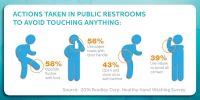Americans Encountering More Unkempt Restrooms, Triggering Negative Perceptions of Businesses Milwaukee, Wis. — The “ick factor” in public restrooms appears to be growing, according to a survey that tracks Americans’ attitudes toward restroom facilities. Almost 70% report they’ve had a particularly unpleasant experience in a public restroom due to the condition of the facilities—a nearly Read more
Public restroom neglect on the rise

Americans Encountering More Unkempt Restrooms, Triggering Negative Perceptions of Businesses
Milwaukee, Wis. — The “ick factor” in public restrooms appears to be growing, according to a survey that tracks Americans’ attitudes toward restroom facilities. Almost 70% report they’ve had a particularly unpleasant experience in a public restroom due to the condition of the facilities—a nearly 20% increase since 2012.
![Bathroom Aggravations_rev0116 copy[1]](https://mechanical-hub.com/sites/plumbing/wp-content/uploads/sites/3/2016/02/Bathroom-Aggravations_rev0116-copy1.jpg) That’s bad news for businesses since Americans say they judge establishments based on the state of their restrooms. According to the 2016 Healthy Hand Washing Survey conducted by Bradley Corporation, most consumers believe a bad restroom indicates poor management, lowers their opinion of the company, shows the business doesn’t care about customers, and makes them think the company is lazy or sloppy.
That’s bad news for businesses since Americans say they judge establishments based on the state of their restrooms. According to the 2016 Healthy Hand Washing Survey conducted by Bradley Corporation, most consumers believe a bad restroom indicates poor management, lowers their opinion of the company, shows the business doesn’t care about customers, and makes them think the company is lazy or sloppy.
“The vast majority—91%—told us that a business with high quality products or services should have high quality restrooms,” says Jon Dommisse, director of global marketing and strategic development at Bradley Corp. “Likewise, in the workplace, 88 percent of workers think the condition of restrooms is one indicator of how a company values its workforce. Yet, only half rate their workplace restrooms as excellent or very good compared to 62% one year ago.
![Avoiding Germs Infographic_0116 copy[2]](https://mechanical-hub.com/sites/plumbing/wp-content/uploads/sites/3/2016/02/Avoiding-Germs-Infographic_0116-copy2.jpg)
Bradley, a manufacturer of commercial plumbing fixtures, washroom accessories, restroom partitions, emergency fixtures and solid plastic lockers for 95 years, also delved into what factors makes restrooms so unappealing. Chief restroom grievances include toilets that are clogged or not flushed; a really bad smell; an overall appearance that’s dirty, unkempt or old; and partition doors that don’t latch closed.
Key restroom improvements Americans would most like to see include improved cleanliness, a completely touchless experience, better stocking of restroom supplies, and a never-ending supply of paper towels—even if there are dryers.
As for restroom improvements they’ve seen over the past two to three years in specific types of facilities, respondents gave the highest marks to medical buildings, airports, restaurants and higher education facilities. At the other end of the spectrum, restrooms in convenience stores, gas stations and truck stops deteriorated the most.

Americans make no secret about their disdain for coming into contact with germs in public restrooms. Restroom entrance door handles, stall handles and faucet handles are the surfaces that make them the most squeamish. Almost 60% of respondents say they operate the toilet flusher with their foot to avoid germs. More than half use a paper towel to cover the door handle while others use their butt to open and close doors.
When it comes to concerns about other people not washing their hands, restaurants and health care facilities are the two types of establishments that give Americans the most anxiety.
“It pays off for businesses to provide clean, stocked, easy to use washroom facilities with touch-free fixtures to ensure the user has a positive experience,” Dommisse said. “In our eighth year of doing this national survey, it remains clear that the condition and cleanliness of the public restroom are always in the spotlight, and affect customer, employee and stakeholder perceptions.”
The Healthy Hand Washing Survey queried 1,062 American adults online Dec. 10-13, 2015 about their hand washing habits in public restrooms and concerns about germs, colds and the flu. Participants were from around the country, were 18 years and older, and were fairly evenly split between men and women (47 and 53%).
